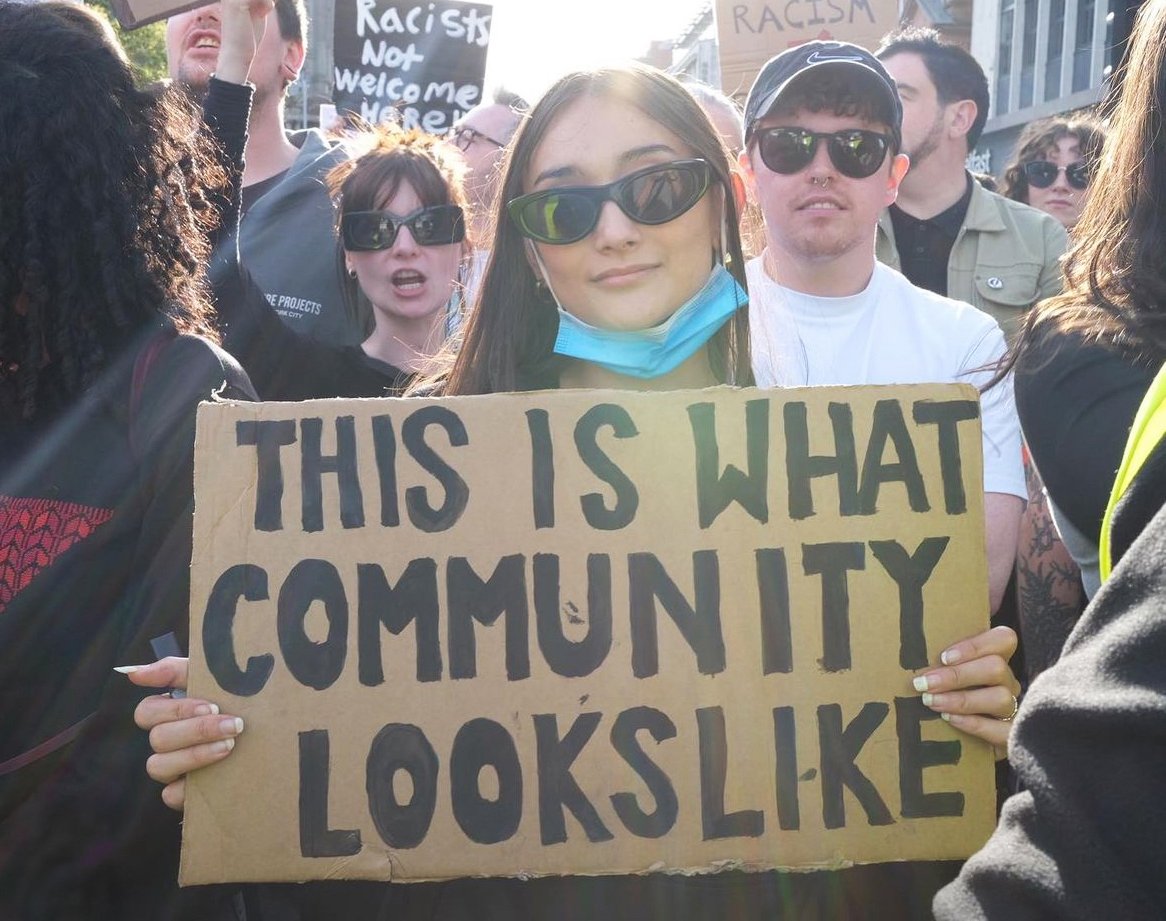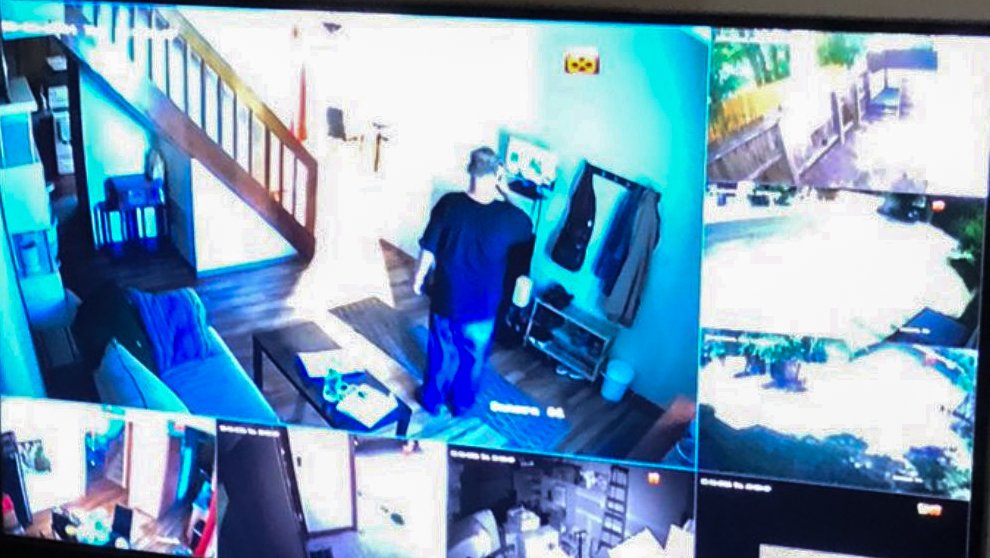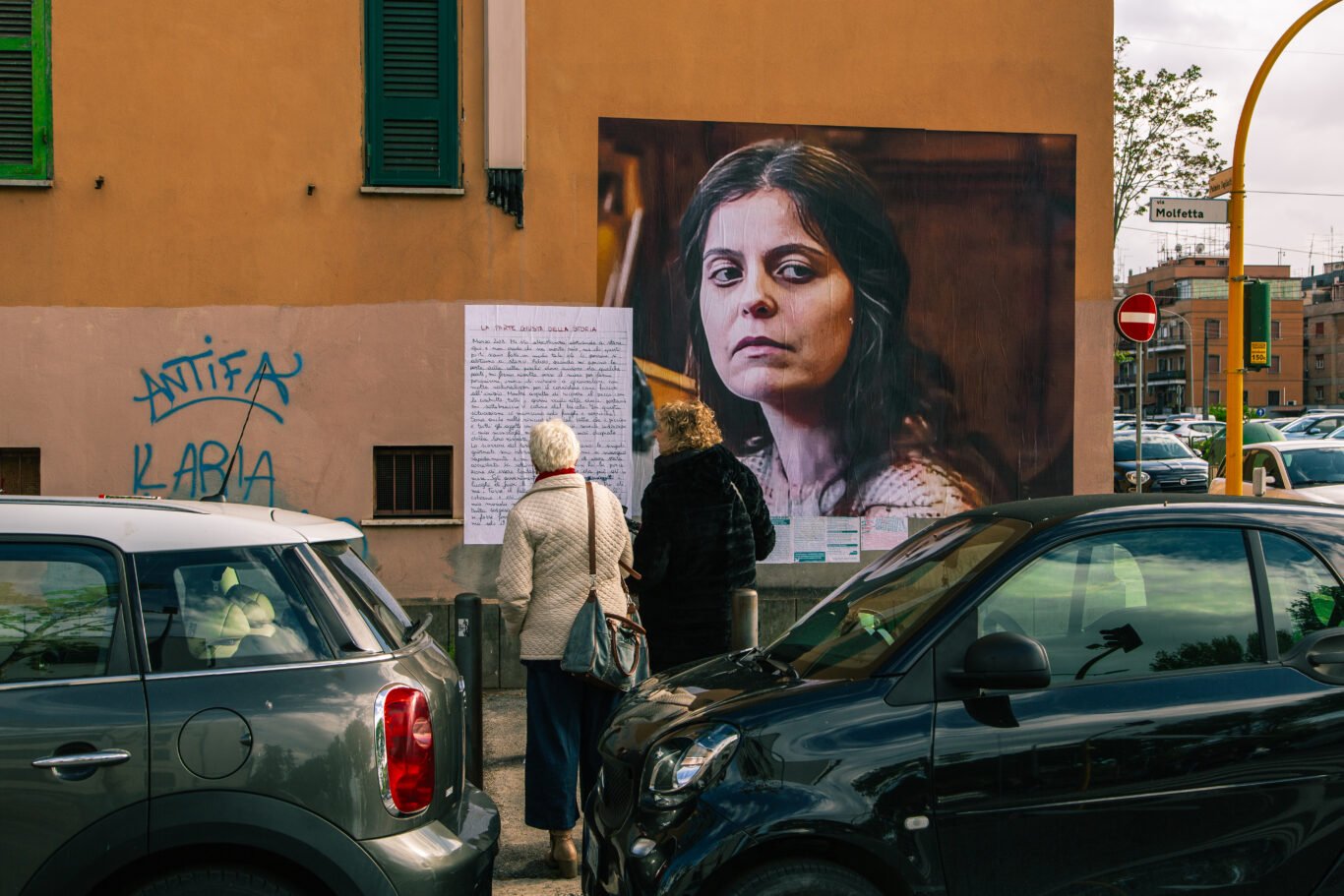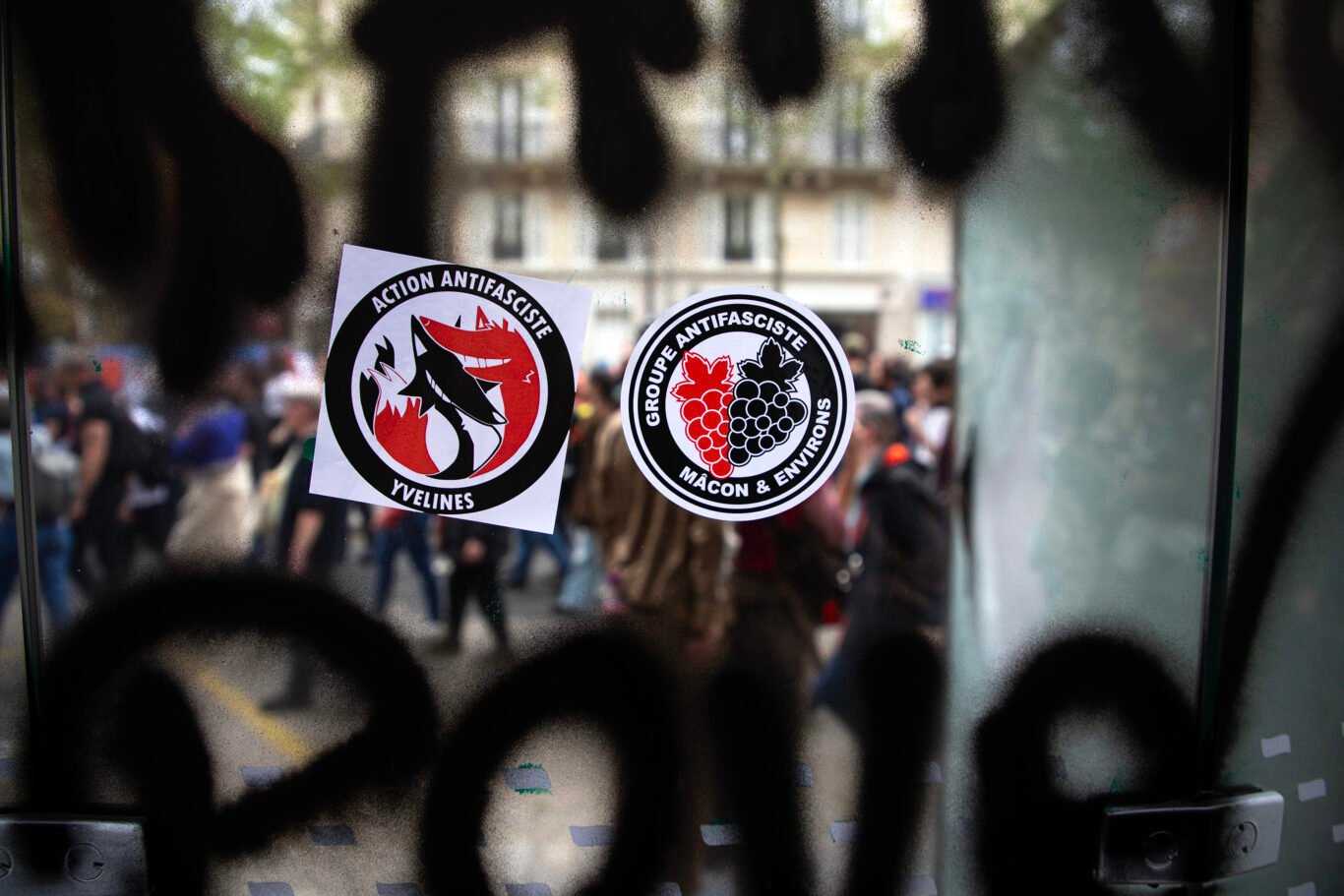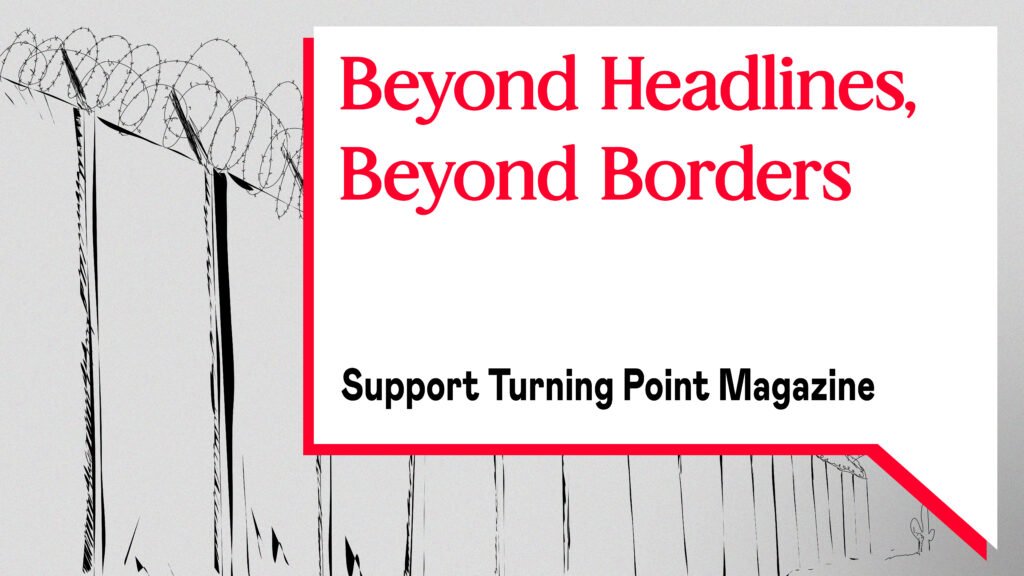Cover photo: Northern Ireland, Belfast, August 9th, 2024. On the sixth day of riots, a strong sense of community emerged at a counter-protest against a rally organized by far-right extremists. With signs reading “This is what community looks like,” protesters gathered to stand against hate and division.
In 2024, the world faced a rising tide of fascist threats. Elections in France saw a resurgent far-right gain momentum, while extremist parties made power plays across Europe. The former US President Donald Trump was re-elected on a campaign of division and hate, and a wave of conspiracy-driven racism led to riots in the UK and Ireland. In the contested six counties of Northern Ireland, still emerging from a decades-long armed conflict, a new kind of violence escalated with a new community in its crosshairs.
In late July, a conspiracy theory about the stabbing deaths of three British girls spread online and became a pretext for racist violence across the UK. In Northern Ireland, the white supremacist perpetrators overcame some of their deep-rooted sectarian divides to target perceived migrants.
As security forces struggled to maintain order, counter-protesters seized the initiative to try and quell the violence, taking up the role the police is ostensibly meant to serve. The riots and the subsequent response can serve as a lesson on the rapid spread of disinformation and disorder, and how to fight back effectively. The violence was also an omen of a more internationalized far right as members of extremist groups from Britain and the Irish Republic were spotted side-by-side in Belfast riots amid reports of transnational online participation in fueling the unrest.
On July 29, an attacker fatally stabbed three girls and wounded ten other people, including eight children, at a dance studio in Southport, England. The main suspect–Axel Rudakubana, a British citizen born in the UK– was only 17 years old at the time, which led police to withhold his name in accordance with the UK’s standard practice regarding underage suspects.
A rumor soon circulated online that an asylum seeker had been responsible for the attack. Just one of the Telegram channels that popped up in the aftermath of the stabbing, named Southport Wake Up, had 14,000 subscribers before being shut down just five days after its creation. A joint-research by British, Danish, and Finnish anti-fascist investigators later revealed that one of the channel’s anonymous administrators, “Mr.AG,” was in fact Charles-Emmanuen Mikko Rasanen, a 20-year-old neo-Nazi in Finland. From his home some 1,800 kilometers away, he fueled the racist frenzy by posting—among other things—a detailed arson manual to the channel soon after a target list of 39 immigration related institutions across the UK was published by another administrator.
“He was not a priorly known Nazi activist [in Finland], and maybe that was the most surprising aspect in this investigation. However, It wasn’t particularly surprising that neo-Nazies cultivate connections or coordinate their activities across borders,” commented Sebastian*, an anti-fascist researcher who assisted the investigation from the Finnish side. He said Finnish and British far right have “at least two decades” history of cooperation, citing the recent participation of Patriotic Alternative leader Mark Collet in a far-right conference in Finland as a good example of their joint activities.
While he said it is customary for the far right to boost events on internet forums and social networks across borders, the experienced investigator did not recall other examples of “anything so organized as managing to create a Telegram channel in a moment just ripe to gain enough followers to actually impact local events.”
On July 30, only a day after the triple homicide, Southport Wake Up channel played a key role in mobilizing the first local riot by rallying a right wing mob at Southport’s Mosque to attack the building and clash with locals. Though the motivation for the gathering was ostensibly a call for “law and order,” the crowd yelled racist slogans and threw bricks at the police. At the time, British police told that some of the attackers were believed to be “supporters of the English Defense League,” the now defunct far-right network that led several anti-immigrant rallies across the UK in the 2010s.
According to Sebastian, the use of social networks to catalyze riots—even from distance or across borders—is a phenomenon of the “internet era” and related to questions about online disinformation and radicalization. “It is directly connected to contemporary social media and global networking, and I would assume similar things to happen more [in future],” he said.
By August 1, a British court issued an untypical order to release Rudakubana’s name and details to quell false rumors surrounding the stabbings, but the damage had been done. By August 3, the unrest had spread to Northern Ireland, with mobs eventually attacking immigrant businesses in Belfast and threatening to attack a local Mosque.
The riots in 2024 were part of a disturbing trend which has seen attacks on migrants and perceived immigrant communities in Europe. In November 2023, anti-immigrant riots caused multi-million damage to public property in Dublin. The rioters used the hashtag #IrelandIsFull to mobilize supporters. In 2022, a French man with a history of racist violence and weapons offenses opened fire on a group of civilians in front of a Kurdish cultural center in Paris, killing three. Such high profile incidents of violence characterize a general increase in hate crimes documented in the UK, France, and other European countries.
According to a European Parliament briefing paper lodged in September 2024, the upsurge in hate crimes has further intensified in the aftermath of Hamas’s October 7 onslaught in Israel and Israel’s subsequent genocidal offensive in Gaza.
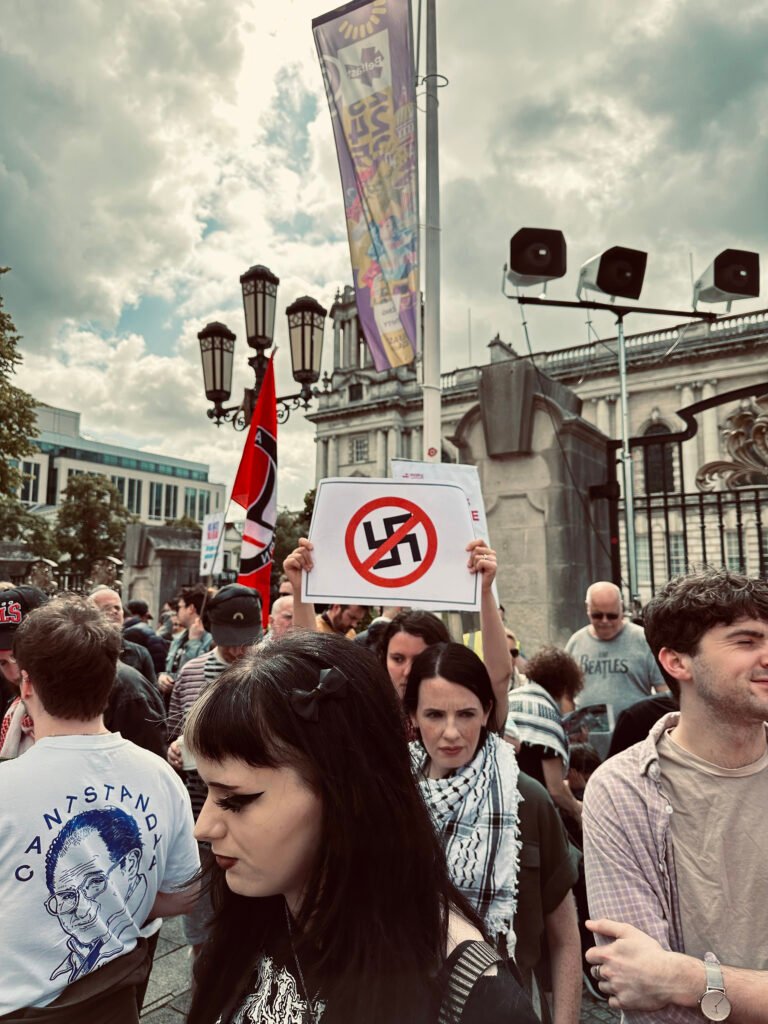
Old Conflict, New Threat
Violence in Northern Ireland has never been limited to Republican-Unionist or Catholic-Protestant divides as the six counties face a serious challenge from organized crime networks with foot soldiers and abundance of weapons. Northern Ireland-based mafia-type organizations are also known to be involved in transnational criminal activity, including smuggling and fraud.
Belfast is notorious for drug crime as well as militant groups carrying out an extrajudicial war against drug dealers, but the Republic of Ireland has also witnessed waves of drug killings. In 2019, a feud resulted in the killings of five young men associated with rival drug gangs in and around the Coolak area of Dublin. During the summer riots this year, right wing activists claiming to represent the neighborhood traveled to Belfast and were seen carrying “Coolock says no” signs alongside loyalists. It is not always clear who is officially acting on behalf of which criminal organization. However, the authorities in Northern Ireland made public statements suggesting a possible loyalist paramilitary link to the violence. Irish and British media have also been rife with speculation that paramilitaries could have played a role in facilitating the attacks against migrants.
During the riots, the intermingling of street hooligans, sectarian militants, and criminal groups without explicit political ideologies manifested itself in strange ways. In one case, Irish nationalist mobs were photographed alongside hardline Unionists with the Irish tricolor flown alongside the Union Jack and symbols associated with the militant unionist Ulster Volunteer Force.
In August, the Belfast Telegraph reported that, during the riots, Irish far-right nationalists from Dublin traveled to Belfast to meet with a notorious paramilitary from the Ulster Defense Association; an organization known for wholesale violence against the Catholic residents of Northern Ireland. The UDA gunman is generally known as “Suspect 4” as he was identified in the investigation into the 1992 gun attack that killed five Catholic civilians at the Sean Graham’s Bookmakers in a heavily republican district of southern Belfast.
Additionally, the Police Service of Northern Ireland arrested Glen Kane, a man previously sentenced to nine years in prison for his role in beating a catholic man to death during a riot in 1992. According to the police, Kane, who has long been active in anti-immigrant activities, was found with anti-immigrant pamphlets as well as Ulster Volunteer Force flag and other Unionist paraphernalia at his residence in the heavily protestant Shankill area of Belfast. He was charged with the possession of abusive material.
The British far-right figure Tommy Robbinson took the cross-sectarian racism as a sign of hope for white nativists. “British and Irish nationalists standing side by side in Belfast. Tricolor and the Union flag on one side, rainbow flags and Antifa flags on the other. It’s happening, ” Robinson posted to X along with a video of counter protesters confronting the anti-immigrant rally.
In Ireland, the surprising scenes provoked an angry response. Taoiseach Simon Harris’ office called the incident “repugnant to everything the Irish flag represents.” The reaction from the British government was also outrage, the British Prime Minister Keir Starmer saying “this is not a protest, it is organized violent thuggery, and it has no place in our streets or online.”
Conservative politicians were muted in their response but did condemn the violence, with former Prime Minister Rishi Sunak saying “this is violent criminal behavior that has nothing to do with the tragedy in Southport,” in a statement posted to X. Nonetheless, mainstream conservatives were accused of equivocating and failing to address the violence.
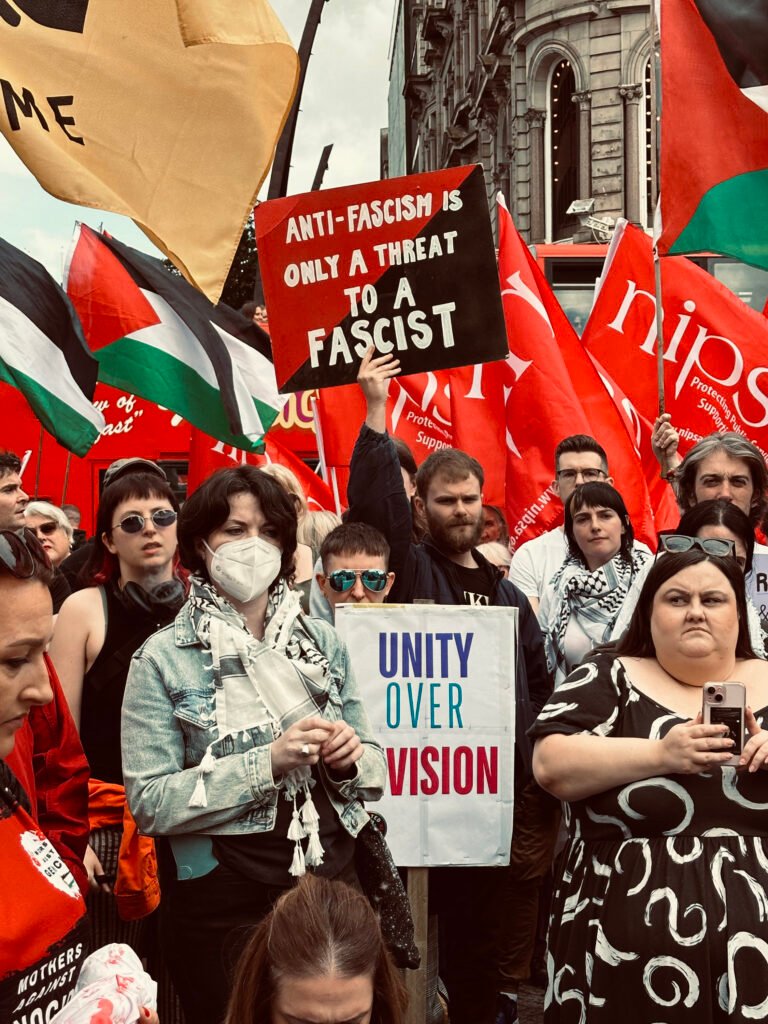
Resistance
Police in the U.K. were at times either overwhelmed or unwilling to confront the violence, leading community members to organize their self-defense in the form of counter-protests that aimed to form a human counterweight against the mob. The Belfast community also organized clean up crews after the riots and helped raise money for people displaced or affected by the melee.
“It wasn’t just rocks through windows, it was hatred with the intention to kill and so we realized that if we did not protect ourselves, then nobody was coming to protect us. So the community stood up… and tried to do whatever we could,” said a Belfast-based activist who took part in the counter-protests and requested to be identified only as Helen* for security reasons.
“We genuinely had zero idea how many people were going to show up, how many of them were going to show up. Police fenced us in on the cobbles of City Hall and created a police line,” said Helen about the August 3rd protest at Belfast’s City Hall.
The right wing mob, whom activists realized were far less numerous than they had feared, began to disperse. “We felt at this point ‘we have to counter, we have to hold the line’ so that’s why they started throwing projectiles across the police line,” Helen recalled. She believes the racist rioters’ lack of familiarity with Belfast helped the anti-racist activists interdict the violence. By mid-afternoon, the rioters had moved their focus to a Mosque in the south of Belfast. In some cases, the people opposing the violence had to physically block access to certain areas.
“There were people from England there, and there were people from Dublin with the fash so they had no idea where they were. They had no idea of the layout of the town; they had no idea how you move in certain areas,” said Helen. “That’s how they ended up on the lower Ormeau while being trapped by ordinary residents who refused to let them through. Apparently facism tourism is a thing,” she continued.
While security forces were deployed, the response was clearly insufficient, and had to be escalated in response to the unrest.
“Police declared a major incident response two days later when the riots did not stop and businesses kept being attacked but, if you look at the charges, now you have charges of attempted murder. It was not just people throwing rocks through windows, it was hatred with the intention to kill,” said Helen. She believes the behavior of the mob alienated much of the general public, including people who vote for anti-immigrant politicians.
Helen also believes radicalization is being driven online and that the audience for racist conspiracies is expanding. “It’s an online radicalization and it’s a male radicalization largely but not just. We have radicalization of women as well,” she said.
While the riots drew in extremists from England and the Republic of Ireland, the counter protests saw solidarity from union figures in England as well as the Republic. Mick Lynch, of the British RMT Rail Trade Union, joined Belfast counterprotestors, telling the crowd “we fought them in the 30s, we fought them in the 50s, we fought them in the 70s in Britain. We will not allow the right wing to dominate our working class communities.”
In Britain and Northern Ireland, Labor Unions continue to support demonstrations against racism, with Stand Up to Racism, among others, holding frequent counter protests against the right-wing nationalists.
“The unions representing health care workers, here the healthcare workers whether they are doctors or nurses or carers a good solid percentage of them are ethnic minorities and some of them wanted to act. You’re not just attacking those people, you’re also attacking health and social care as a whole, it wasn’t so long ago they were clapping for the NHS, so what the fuck is going on,” said Helen. “So those unions, they came here and they named the paramilitary threat for what it is.”
Organizers and citizens also raised tens of thousands of pounds to help people who had been displaced and affected by the violence with housing and transportation.
“I don’t think that what happened this summer is going to be a one off. History dictates that it isn’t,” said Helen.
While Northern Ireland’s fractured political parties did condemn the violence and “all forms of racism” with a motion in the Northern Ireland Assembly on August 8, the blindness and weakness of the political establishment across the UK and Northern Ireland stood in stark contrast to the quick response of grassroots anti-racist organizers. Large anti-racist demonstrations on August 10 marked an effective end to the riots. Though the heat had been turned down, attacks on perceived immigrants continued, including an arson attack against a Mosque in the early hours of August 10.
While the racist riots were catalyzed by disinformation spread in social networks, the same platforms and applications were used by anti-racist demonstrators to help raise awareness of the danger, to mobilize their communities, and expose the extremists to public scrutiny with an eye on future threats. Anti-fascism cannot be limited to hopes and prayers that elected officials will take morally brave positions while fascists use intimidation in the streets. It cannot rest in hopes that fascists and anti-fascists are monolithic groups that never change, evolve, or venture out into the world. Democracy and safety cannot rely on “blue walls” and “silent majorities,” and cannot be protected if people keep fighting the struggle as it was decades ago. Northern Ireland is a lesson that anti-racists must also avoid the mistake of being stuck in the past. Voting is only one tool in Democracy’s tool kit, and fascists cannot be given control of the streets while others hope for miracles from the leaders.
*Names Sebastian and Helen in this article have been anonymized to protect the sources’ security amid threats to their health or life.

Patrick Hilsman
Researcher and journalist focused on conflicts, arms traffic and refugees. Hilsman has covered the conflicts in Syria and Ukraine, and works currently as an editor at Turning Point.
